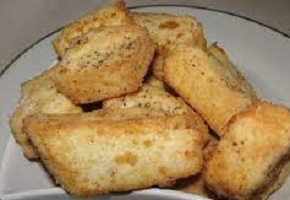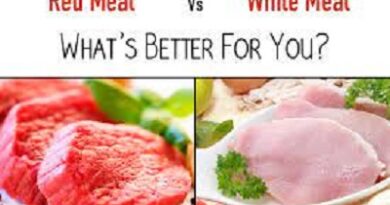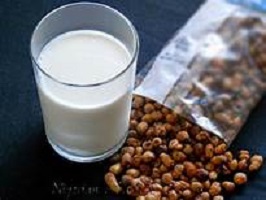Nigerian Wara: How to Make West African Cheese Curds
Nigerian Wara: How to Make West African Cheese Curds

- Wara – Milk Curds – Tastes & Flavours of West Africa local delicacy
- Wara Food native cheese
- Fried Wara: Nigerian Local Cheese Curds
- Nigerian Wara Soya (Tofu) Recipe
Wara: How to Make West African Cheese Curds – Overview
Nigerian Wara food is an unripened cheese commonly sold by Nigeria’s Nomadic Fulani. It is traditionally made by heating fresh cow milk and coagulating it with Sodom apple or pawpaw leaves.
These days, many other coagulants are used, such as lemon juice, starter culture, and chemicals.
Wara, contrary to popular belief, is not cheese. Milk curds are produced by adding a coagulant to fresh milk, whereas cheese is produced by aging pressed milk curd.
Some called it wara soya, while others called it beske or local tofu. This is a delicious and healthy snack made from soybeans.
Furthermore, Wara is not a fermentation product. It is made by heating milk with a coagulant added to curdle the milk protein.
Unripened vs. ripened cheese
The difference between unripened and ripened cheese is that unripened cheese is made by coagulating the milk proteins, similar to how Wara is made, and it is consumed fresh.
Ripened cheese is made by coagulating milk proteins with enzymes and culture acids, but it is also aged/matured with bacteria or mold.
Nigerian wara is typically sold in polyethylene bags and in a liquid consisting of whey (lactose and water) separated from casein (protein) during coagulation.
The casein is then used to make the Wara.
Wara is a scrumptious addition to meals when it is produced with safety in mind.
It can then be a nice addition to the family meal, and everyone can enjoy it, including infants and toddlers.
What is Nigerian Wara?
Wara is a simple tasty locally made Nigerian cheese curd generally made from fresh cow milk.
It is thought to have originated in Wara, a city in Kwara state.
It is known by various names in different parts of the world, including Cottage cheese in the United States, Paneer in India, Woagachi or Wagassirou in Benin, and Mashanza in Zaire.
In its most basic form, Nigerian wara is made by curdling milk (either animal milk like cow/goat milk or plant milk like soya milk).
After the curdling process, the solid part (proteins and fats) is separated from the liquid part (water and whey) and pressed together.
Wara Nigeria
It is a sold piece of curdled milk with a squeaky texture that is usually eaten alone, as a snack once fried (known as Beske), or as an addition to various cuisines.
It is usually white, unsalted, and uncolored after it has been prepared. Due to the short shelf life of the cheese, it is frequently sold within a day of manufacture.
Wara is traditionally made in Nigeria by adding a coagulant (extract from Sodom apple, also known as bomubomu in Yoruba) to fresh boiling cow’s milk to curdle it.
Coated milk protein (casein) and whey are the end products. This milk protein is then separated from the whey and marketed as wara.
Additional processing, such as boiling and frying, can be used to firm up the wara before it is cooked in stews and soups.
Wara can be eaten and enjoyed fresh as it’s produced
Wara, contrary to popular belief, is not cheese. Milk curds are created by adding a coagulant to fresh milk. The process of making cheese involves aging pressed milk curd.
As a result, wara does not and should not have a sour fermented flavor. If this is the case, it is no longer fresh.
Taste of Wara
Wara taste is best experienced rather than described. It has the flavor and texture of boiled egg white.
Some people find wara to be bland, but it can be improved with salt, pepper, and other seasonings. When added to soups or stews, the wara absorbs all of the tastes and flavors.
Properties of fresh Wara
- The texture of fresh wara is jiggly and soft, and it is quite delicate.
- Fresh wara will be sold in its whey, which has a light yellow color and can be easily broken.
- Because wara is not a product of fermentation, it does not have a fermented sour taste like cheese. It’s made by heating milk with a coagulant to curdle the milk protein.
- Wara is high in protein, making it a very healthy alternative to meat or fish.
Wara classifications ~ Types of wara
Based on the starting ingredients, there are two main types:
- One made from fresh cow’s milk
- the one made from soybean milk (also called tofu or soya wara)
Health Benefits of eating Wara
The main component of wara is casein, a milk protein that gives the product its white color.
This results in wara being extremely high in beneficial protein (usually 10-12%), which varies depending on the quality of the milk and the amount of coagulant used.
It is well known that milk proteins contain amino acids that are necessary for the proper functioning of the human body.
Milk curds, such as wara, are also high in methionine, an essential amino acid that, among other things, protects the liver from becoming fat.
Wara protein is easily digested and absorbed by the body, making it an excellent source of RDA protein. They are also an excellent meat substitute.
Wara Cooking/Eating Methods
- Wara can be eaten fresh.. (though I tend not to do this due to the uncertainty of how its made). Before eating, I usually cook it further by boiling or frying it.
- Wara can be deep-fried, then drained and cooled before being added to soups or stews.
- Wara can also be grilled and added to salads.
- Grilled wara is a delicious snack.
Interested in making Wara? Below is a typical Nigerian Wara recipe:
How to make wara – Production of Wara Cheese (Fresh milk version)
I on one occasion heard about the delicacy Wara and I pondered what it was.
Years later, I heard about it again and how delicious it is, and as a foodie, it piqued my interest. I gave it a shot, and let’s just say I haven’t looked back since.
Wara Ingredients
To make wara the traditional way, you’ll need freshly squeezed cow milk and plant extract from a specific leaf known as “bomubomu” or “ewe bomu bomu.” Calotropis procera is the botanical name for this plant, and Gaint milkweed is the common name.
This acts as a coagulant, causing the milk to curdle. You’d also need a conical-shaped woven basket, which is typically used to separate curds (coagulated cheese) from whey (clear liquid).
Other acidic alternatives that perform as a coagulant include; lemon, white vinegar, lime juice, apple cider vinegar magnesium chloride.
Technique
To make wara, 5 liters of milk would give you around 1 kilogram of cheese
- Firstly, prepare the juice extract from the leaves. To make this, you cut about 7 bomubomu leaves and place them in a bowl.
- Then, pour about half a cup of warm water over the leaves and leave to infuse for about 10 minutes.
- Secondly, pour the fresh cow milk into a pot. Lower the heat and slow cook. This normally takes 15-30 minutes
- Thirdly, sieve the liquid into the milk in the pot. When you do that, you’ll see the curds start to separate from the whey instantly. If they don’t separate, add more juice.
- After that, continue to stir it so that it does not burn. The whey (liquid) would become clearer over time, while the curds (solid) would become larger.
- Now, separate the curds from the whey with a strainer. Pour everything into the woven basket or a pap/cheese sieve and strain. Whey protein is very important and nutritious for other things, so don’t throw it away.
- Meanwhile, allow the whey to drip out of the cloth or basket before squeezing out the excess liquid.
- Lastly, to keep it fresh, the sellers usually add water. And your wara is complete. It can be fried to make Beske or added to salads or dishes.
FAQs
How is Wara Made?
Wara is produced by boiling milk with a coagulant added to curdle the milk protein.
What were the outcomes?
Whey protein and coagulated milk protein (the liquid remaining after milk has been curdled and strained). This milk protein is then separated from the whey and marketed as wara.
Additional processing, such as boiling and frying, can be used to firm up the wara before cooking it in stews and soups.
In Nigeria, what is wara?
Wara in Nigeria is simply delectable cheese curds made primarily from fresh cow milk.
It is thought to have originated in Wara, a city in Kwara state.
Is wara a type of cheese?
Wara, contrary to popular belief, is not cheese.
Milk curds are produced by adding a coagulant to fresh milk, whereas cheese is produced by aging pressed milk curd.
You can refer to it as “local Tofu.”
How do I go about making wara?
Firstly, place a clean handkerchief or the cloth used to make pap over a bowl in the sink and carefully pour the milk.
After that, squeeze the cloth to extract as much milk as possible. Allow cooling for four to five hours.
Finally, dice into desired sizes and then, season with salt, pepper, and seasoning cubes
How do you fry wara? How to Fry Wara
- Firstly, drain the wara to remove all the whey that came with it.
- Then sprinkle salt and black pepper on the drained it
- After that, toss and allow to stand for a few more minutes, and then fry.
- Alternatively, you can opt for shallow or pan frying instead of deep frying.
- Lastly, drain off excess oil.
What does wara mean in Hausa?
Soya bean cake is known as wara in Hausa. Nigerian wara is made with soya beans, fresh pepper, magnesium chloride (which aids in the coagulation of soya milk), and seasoning cubes.
Is tofu synonymous with wara?
Some called it wara soya, while others called it beske or tofu. This is a delicious and healthy snack made from soybeans.
What is wara in Islam?
Wara (Arabic: وَرَع) is a word that means piety. It is a spiritual state that protects and keeps the soul from slipping.
Wara’ is a higher position than taqwa in which a person avoids doubtful issues and even permissible actions that may lead to sins.
What is the English name for wara?
Wara {interjection}
Is cheese consumed in Nigeria?
Morocco had a 44 percent share, while Egypt had a 32 percent share.
In contrast, the African countries with the lowest cheese consumption were Zambia, Nigeria, Uganda, Kenya, and Burkina Faso.
Is wara beneficial to one’s health?
Wara is high in protein, making it a very healthy alternative to meat or fish.
What is tofu made of in Nigeria?
Tofu, a coagulated product of soybean milk, is typically produced at the household level in northern Nigeria using a variety of coagulants such as calcium salt, magnesium salt, alum, and steep water (effluent from pap produced from maize).
Is tofu a type of cheese?
Paneer and tofu are not the same things, despite their appearance. Paneer is a type of cheese, whereas tofu is made from soy.
They are, however, both vegetarian sources of protein and calcium with mild flavors and soft textures.


